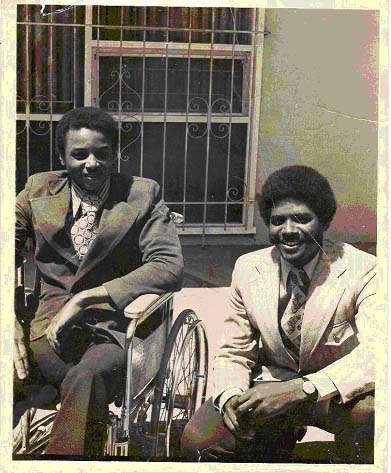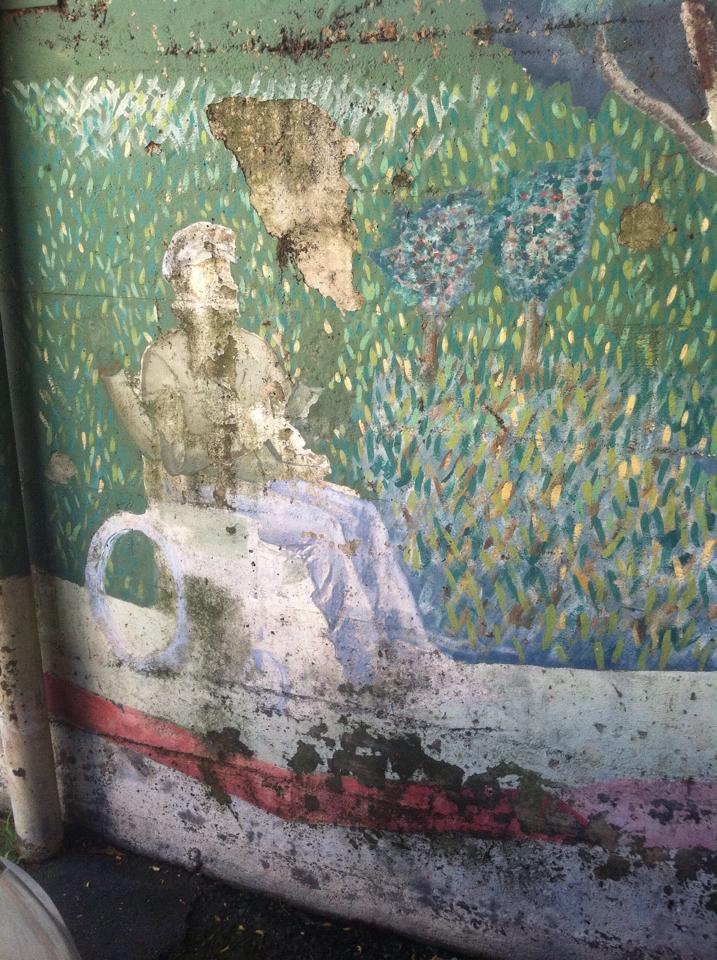Plans exist to demolish the original headquarters of the Center for Independent Living at 2539 Telegraph and to build a “car-free” 5- to 6-story, 70-unit mixed-use complex on the site with about 6,100 square feet of ground floor commercial space.
The Berkeley Center for Independent Living opened in 1972, guided by a philosophy of disability that holds:
- Disabled peoples themselves know best the needs of disabled people and how to meet those needs.
- The needs of the disabled can be met most effectively by comprehensive programs which provide a variety of services.
- Disabled people should be integrated fully into their community.
Today the locus of CIL’s disability activism has shifted to the Ed Roberts Campus on Adeline, but the CIL office on Telegraph remains, awaiting the developer’s wrecking ball.
On a wall on the south end of the parking lot is a mural, eight feet high, 75 feet long, painted when the CIL moved into the building in 1977. That mural exists in the future perfect tense.
It is commonly reported that Ed Monroe painted the mural. On the other hand, in their 1980 A Survey of East Bay Murals of the 1970s, Tim Drescher and Ruth Goldman wrote: “This mural was painted by one of Laney College’s mural workshops, led by Gary Graham. The mural was spontaneously painted with the ideas of the Center for Independent Living. It was painted with help from the members of the Center.”
In any event, it depicts many of the pioneers of the disability rights movement. Ken Stein, a disability historian and lifelong disability rights advocate, helped me identify the men and women shown in the mural.
This depicts architect Mary Ann Hiserman, an early resident and probably the first woman resident, of the old Cowell Residence Program, which was precursor to U.C. Berkeley’s Physically Disabled Students Program, which was the precursor to the CIL.

Mary Ann Hiserman. Photo: http://www.sarkissian.com.au/wendys-blog/professional-posts-by-wendy-sarkissian/remembering-mary-ann-hiserman/#sthash.S8VpzbG9.dpbs
Wendy Sarkissian writes about Hiserman: “Mary Ann spent nearly her entire academic and professional career at Berkeley, was a member of the staff since 1977 and received both her BA and master’s degrees in architecture from Berkeley. In her capacity as campus access coordinator, Mary Ann saw that all campus buildings at Berkeley met handicapped compliance codes. She coordinated the Chancellor’s Committee for the Removal of Architectural Barriers and was an access consultant for two local municipalities.”
The mural shows her in an archery class, from a photo in CIL’s national quarterly, The Independent
Michael Williams is in the wheel chair.
His work revolved around Augmented Communications (the communication methods used to supplement or replace speech or writing for those with impairments in the production or comprehension of spoken or written language).
The African American man in a suit to his right and holding a white cane is Don Galloway, then head of CIL’s R&D department. According to Lead On Network, “Mr. Galloway’s introduction to the independent living movement came in 1974. Ed Roberts invited him to work with the Center for Independent Living as its director of services for blind people and soon began pressing the almost entirely white independent living movement to become more inclusive of people of color.” See this for more or this stirring obituary.
This close-up of Williams suggests the power of the mural – his eyes seem to find you no matter where you are standing.
Here is Brad Lomax getting into Charlie Brown’s red van. Brown would later marry Jan McEwen, CIL founder and editor of CIL’s national quarterly magazine, The Independent.

Brad Lomax and his brother Glenn. Photo: http://leadonnetwork.org/wordpress/2016/02/09/black-disability-history-brad-lomax-black-panther-revolutionary-black-nationalism-and-disability-power/
Lomax was a disabled Black Panther and a disability rights/independent living movement leader who played a key role in the San Francisco sit-in in 1977 to force the Department of Health, Education and Welfare to adopt meaningful regulations implementing Section 504 of the federal Rehabilitation Act. The involvement of the Panthers in the sit-in speaks to the radical nature of early disability rights activists.
Dale Dahl, born deaf, was 24 years old when a car accident left him with a spinal cord injury that led to incomplete quadriplegia.
He started the Deaf Services within the CIL, took part in the Section 504 sit-in, and forged alliances between the deaf and mobility disability communities. What looks like facial hair is dirt on the mural.
Photo: Ken Stein
This very faded image depicts Nancy D’Angelo, early Attendant Referral.
Time has obviously taken its toll on the mural, and it may not survive the developer’s wrecking ball. The original artist – Ed Monroe – is not upset about the possible demolition of the mural. He told Berkeleyside – Paint another one. That’s his solution.
The mural is visible from the sidewalk. It’s probably going soon. I urge you to take a last look at it.
Because of CIL and its predecessor organizations, Berkeley and the greater Bay Area are, in the words of Ken Stein, “widely regarded as the birthplace and spiritual center of the modern independent living movement.” Stein further wrote:
Those of us who participated in the 504 sit-in; those of us who have shared in the growth and development of any of the multitude of independent living, disability access and disability rights organization; those of us who have participated in and supported public policy development and advocacy, or who have demonstrated for the rights of persons with disabilities over the past six decades: all of us have reason to be proud and reason to celebrate. It is no exaggeration to say that we each have participated in, and have been an integral part of, one of the greatest and most successful people’s moments of the 20th century.
I showed the photos to my friend. Long silence.
What does he think about the post?














Thanks for this living history lesson!
Long live CIL and high praise for those who started our long struggle for civil rights and equal opportunities!
When I try to open your email about Laurel Skye’s mosaic work, it only goes to the CIL mural article. What gives?
Click on the photo or the headline. Sorry. The URL is http://quirkyberkeley.com/holiday-field-trip-laurel-skye-out-of-the-rubble/